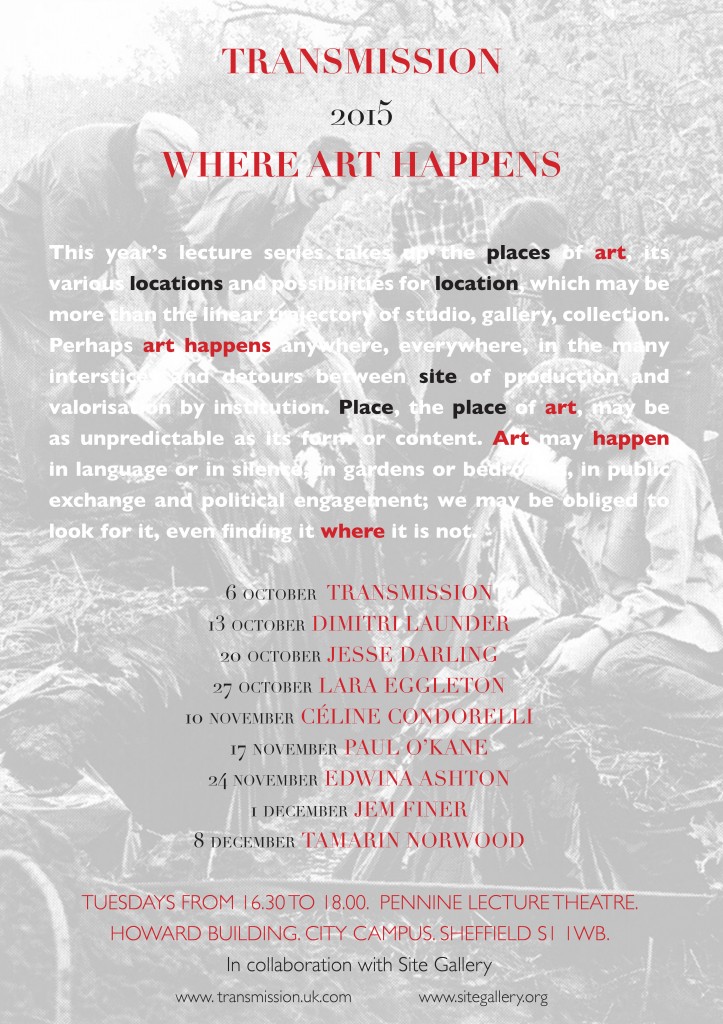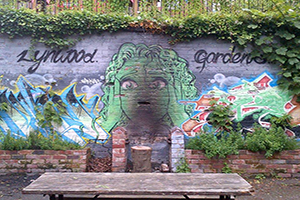
Transmission, the lecture series collaboration between Site Gallery and Sheffield Hallam University has returned once again for its 2015/16 run. Transmission, which began in 2002, has become a window into the art world and the individuals who populate it – and those who aspire to it – whilst also being free and open to all. This year’s Transmission explores the Places of Art – where it is and can be produced, found and seen. This theme keeps true to the core purpose of Transmission: the examination of artistic processes and thought – the how and why – of becoming an artist. The first installment of the series, chaired by Julie Westerman, was a presentation given by Dimitri Launder; a designer, visual artist and performer – who engaged his audience with his personal narrative and the trials and tribulations which he has experienced throughout his career.
The beginning of the lecture saw Launder informing the aspiring artists in the audience (who were furiously taking notes) of the importance of self-determination in order to forge their own path into the art world. Not to mention the importance of a regular income. Alongside Launder’s artistic praxis he is a successful garden designer, founding ‘Artist Gardeners | Sculptural Concepts | Edible Planting’ in 2000, a career which both enables and complements his artistic endeavours as he proudly declared that he harnesses the “political power of plants and isn’t afraid to use it.”
The pervading theme of the lecture was, naturally, places of art and Launder is an artist who explores site in an urban context, connecting with the locality of the place and “romances” it. Though he claims that something about the work always exists before the site has been chosen it is undeniable that Launder’s work and site form a collaborative dialogue. Consider AREA10, the Peckham arts charity and experimental artist run platform co-founded by Launder in 2002. This site not only inspired the 2,000+ artists with its endless cavities and malleability but it also provided the materials which were intrinsic to their creative practice.
Launder’s work stems from “a need to say something back to the social and political situation of the time”; to create a dialogue between the work and the site, the site and the observer. Launder’ design based projects (such as Foucault’s Cradle) become interventions into the city. But they also incite conversations about issues appertaining to our society; concepts of security and of sacred space.
As the lecture progressed, however, we learn that places of art are risky – namely the risk of criminalisation. But the general consensus is that risks are a necessity, particularly in the early stages of an artist’s career; one must enjoy the “mixture of romance, idealism and naivety” in order to develop one’s knowledge of the contemporary art industry.
Launder also spoke candidly about the funding issues which have hindered some of his projects. His visual piece, for example, ‘The Desire Machine’ took 12 months to secure funding. Though it is disheartening to realise that in our contemporary society creative vision alone is not enough it was refreshing to hear an artist confess the need of garnering corporate support in order to create a project. Compromises such as this do have perks however. Alliances with corporate bodies have enabled him to access spaces which would not ordinarily have been available to him. For Launder the viability of his art happens in the funding proposal and though it is not ideal, this is the current climate of the art industry.
Have a look at the lecture programme here.
Words: Holly Hinchliffe.




1 comment